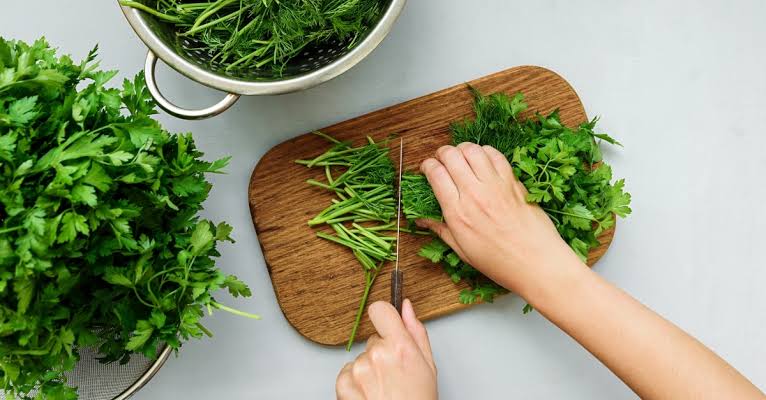Parsley is a green herb. People use it in cooking to add flavor and make their food taste better. It is a small plant that grows in gardens and pots. You can easily find it in the grocery store.
Parsley comes in two types; curly parsley and flat-leaf parsley. Curly parsley has leaves that look like small, green curls. Flat-leaf parsley has flat leaves and is also called Italian parsley. Both types of parsley taste similar, but some people prefer one over the other.
One great thing about parsley is that it’s very easy to grow. You can plant parsley seeds in your garden or a pot and watch them sprout into healthy plants. It likes to grow in a sunny spot with good soil. Just make sure to water it regularly, and it will thrive.
People use parsley in many different dishes. It’s often used as a garnish, which means it’s placed on top of the food to make it look pretty. But parsley is not just for decoration; it has a fresh, slightly peppery taste that can enhance the flavor of your meals.
You can chop parsley finely and sprinkle it on salads, soups, and grilled meats. It adds a burst of green color and a delightful taste. Some people even use it to make sauces and pesto. Parsley is a versatile herb that can be used in various cuisines around the world.
Apart from its delicious flavor, parsley also has some health benefits. It’s a good source of vitamins like vitamin C and vitamin K. These vitamins help keep our bodies healthy. Some people also believe that parsley can freshen your breath, so you might see it on your plate at a fancy restaurant.
In addition, parsley is a simple yet wonderful herb. It grows easily, adds a lovely flavor to your food, and is good for your health. Whether you choose curly parsley or flat-leaf parsley, you can enjoy its taste and the beauty it brings to your dishes.
Read Also: How Much Milk You Can Get From A Goat
Growing Parsley
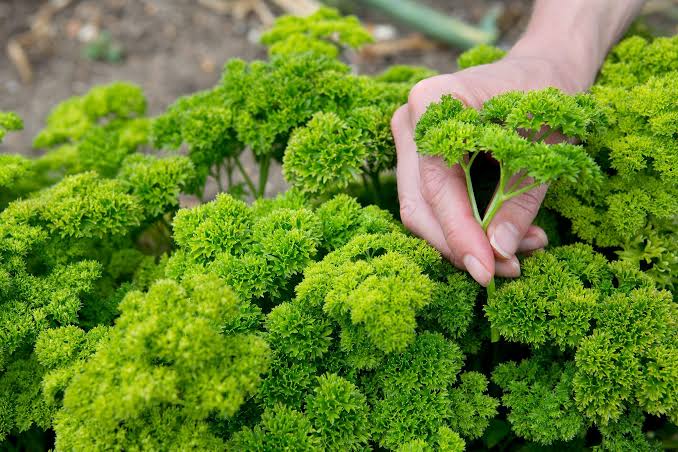
Growing parsley is an enjoyable and straightforward gardening endeavor. Whether you have a garden or just a small pot on your windowsill, parsley can thrive with a little care. Here are some simple steps to help you grow your own parsley:
1. Choose the Right Variety: As mentioned earlier, there are two common types of parsley: curly and flat-leaf (Italian). Choose the one that suits your taste preferences.
2. Select a Suitable Location: Parsley enjoys plenty of sunlight but can tolerate partial shade. Ensure it gets at least 4-6 hours of sunlight each day.
3. Prepare the Soil: Parsley prefers well-draining soil that’s rich in organic matter. You can improve your garden soil by adding compost or well-rotted manure. If you’re growing parsley in a pot, use a high-quality potting mix.
4. Planting Parsley Seeds: You can either start parsley from seeds or buy young plants from a nursery. If planting seeds, sow them about 1/4 inch deep in rows, leaving some space between each seed. Water gently after planting.
5. Watering: Keep the soil consistently moist, but avoid overwatering, which can lead to root rot. Water the soil, not the leaves, to prevent fungal diseases.
6. Thinning: If you planted parsley from seeds, you might need to thin the seedlings once they are a few inches tall. Leave about 6-8 inches of space between each plant.
7. Mulching: Adding a layer of mulch around your parsley plants helps retain moisture, keeps the soil temperature stable, and prevents weeds.
8. Fertilizing: Parsley doesn’t require heavy feeding. You can apply a balanced, slow-release fertilizer once or twice during the growing season, following the package instructions.
9. Harvesting: You can start harvesting parsley leaves once the plant has several stems with three segments each. Snip the outer leaves, leaving the inner ones to continue growing. This way, you’ll have a continuous supply of fresh parsley.
10. Overwintering: Parsley is a biennial plant, which means it typically lives for two years. In the first year, it produces leaves, and in the second year, it may produce flowers and seeds. If you want to keep your parsley going for a second year, protect it from harsh winter conditions.
11. Pests and Diseases: Keep an eye out for pests like aphids or caterpillars and treat them promptly. Proper spacing and good air circulation can help prevent fungal diseases.
Growing parsley is a rewarding experience for both novice and experienced gardeners. With a little attention and care, you can have a fresh supply of this flavorful herb for your culinary creations. Try and get your own gardening gloves and start cultivating your parsley garden today.
Fresh Parsley to Dried
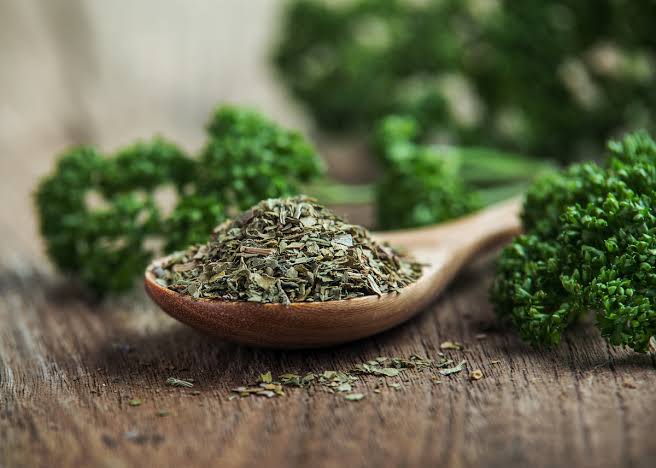
Fresh parsley is a green herb that many people use to add flavor and color to their dishes. But did you know that you can also turn fresh parsley into dried parsley? Dried parsley is a handy ingredient to have in your kitchen, as it can be used in a variety of recipes. Lets quickly take a look at the process of turning fresh parsley into dried parsley and the benefits of using dried parsley in your cooking.
To start, you’ll need some fresh parsley. You can find fresh parsley in the produce section of most grocery stores. Look for parsley that is bright green and free from wilting or yellowing leaves. It’s best to use fresh parsley that is still in good condition.
Once you have your fresh parsley, the first step is to wash it thoroughly. Rinse the parsley under cold running water to remove any dirt or debris. Pat it dry with a clean kitchen towel or paper towels. It’s important to make sure the parsley is completely dry before moving on to the next step.
Next, you’ll want to remove the leaves from the stems. You can do this by holding the stem with one hand and using the fingers of your other hand to strip the leaves off in the opposite direction of growth. Discard the stems, as they are not typically used in dried parsley.
Now that you have a pile of parsley leaves, it’s time to dry them. There are a few methods you can use to dry parsley. One common method is to tie the parsley leaves into small bundles and hang them upside down in a dry, well-ventilated area. This allows the leaves to air dry naturally. Alternatively, you can place the parsley leaves on a baking sheet and put them in an oven set to the lowest possible temperature. Keep a close eye on them to ensure they don’t burn. It may take several hours for the parsley to fully dry using this method.
Once the parsley leaves are completely dry, you can crumble them into a fine powder using your fingers or a mortar and pestle. Store the dried parsley in an airtight container in a cool, dark place. Dried parsley can be kept for several months, and it retains much of its flavor and aroma.
Now that you have your dried parsley, you can use it in a variety of dishes. It’s a great way to add a burst of flavor to soups, stews, sauces, and salads. Dried parsley can also be sprinkled on top of roasted vegetables or used as a garnish for pasta dishes. It’s a versatile herb that can elevate the taste of your meals.
In addition, turning fresh parsley into dried parsley is a simple process that allows you to preserve this flavorful herb for later use. With a little time and patience, you can create your own supply of dried parsley to enhance your culinary creations. The next time you have some fresh parsley on hand, consider drying it for a convenient and tasty addition to your kitchen pantry.
Read Also: How to Hand-milk a Goat, Follow These Steps
Curly Parsley
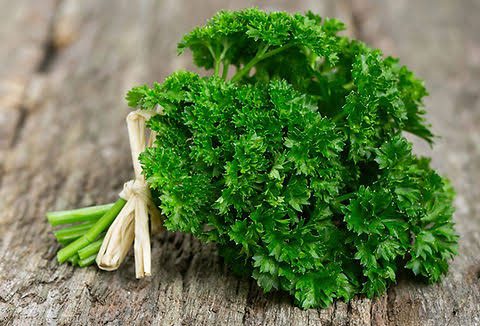
Curly parsley is a type of parsley known for its distinctive curly leaves. It is a popular herb used in cooking, particularly as a garnish, due to its vibrant green color and fresh, mild flavor. Curly parsley is often confused with its flat-leaf counterpart, Italian parsley, but they have some differences in taste and appearance.
One of the most noticeable characteristics of curly parsley is its curly or ruffled leaves. These leaves are bright green and have a serrated edge, giving them a decorative and ornamental quality. While curly parsley is certainly aesthetically pleasing, it’s also a versatile herb in the kitchen.
Here are some key points about curly parsley:
1. Flavor: Curly parsley has a milder flavor compared to flat-leaf parsley. It is less assertive and has a fresh, slightly peppery taste. This mild flavor makes it a great choice for garnishing dishes without overpowering their taste.
2. Culinary Uses: Curly parsley is often used as a garnish for a wide range of dishes, including soups, salads, and entrees. Its bright green leaves can add a pop of color and freshness to any plate. It’s commonly used to decorate and enhance the presentation of meals.
3. Nutritional Value: Like other varieties of parsley, curly parsley is rich in vitamins and minerals, including vitamin C, vitamin K, and iron. It’s a healthy addition to your diet, and its mild flavor makes it easy to incorporate into various recipes.
4. Growing Curly Parsley: If you want to have a steady supply of curly parsley, you can grow it in your garden or even in pots on a sunny windowsill. It’s a hardy herb that’s relatively easy to cultivate.
5. Culinary Companions: Curly parsley pairs well with a variety of other herbs and ingredients. It’s often used alongside basil, oregano, thyme, and garlic in Mediterranean and European cuisines.
However, curly parsley is a delightful herb with decorative curly leaves that add visual appeal to dishes. Its mild flavor and versatility make it a popular choice for garnishing and enhancing the presentation of a wide range of culinary creations. Whether you’re sprinkling it on a salad or using it as a finishing touch for a main course, curly parsley is a valuable addition to your kitchen herb collection.
Parsley Leaves
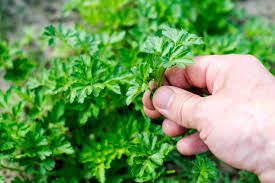
Parsley leaves, often simply referred to as “parsley,” are the green, leafy portions of the parsley plant (Petroselinum crispum). Parsley is a popular herb used in cooking, known for its fresh, mild flavor and vibrant green color. It comes in two main varieties: curly parsley and flat-leaf parsley, also known as Italian parsley. Both types of parsley have similar culinary uses but differ slightly in appearance and flavor.
Here are some key points about parsley leaves:
1. Culinary Uses: Parsley leaves are a versatile herb used in a wide range of culinary dishes. They can be used both as a flavor enhancer and as a decorative garnish. Parsley is commonly used in salads, soups, sauces, stews, and as a finishing touch on various savory dishes.
2. Flavor Profile: Flat-leaf parsley has a stronger, more robust flavor compared to curly parsley. It has a fresh, slightly peppery taste with hints of citrus and earthiness. Curly parsley, on the other hand, has a milder flavor.
3. Nutritional Value: Parsley leaves are nutritious and contain essential vitamins and minerals. They are a good source of vitamin C, vitamin K, and vitamin A. Additionally, parsley is rich in antioxidants, including flavonoids and carotenoids.
4. Culinary Companions: Parsley leaves pair well with a wide range of other herbs and ingredients. They are often used in conjunction with herbs like basil, oregano, thyme, and cilantro to add depth of flavor to dishes.
5. Garnish: One of the most common uses of parsley leaves is as a garnish. The vibrant green color and appealing texture of parsley make it an excellent choice for decorating plates and adding a pop of color to a variety of dishes.
6. Varieties: As mentioned earlier, there are two main types of parsley leaves—curly parsley and flat-leaf parsley. Curly parsley is often used more for garnishing, while flat-leaf parsley is preferred for its stronger flavor and is often used in cooking.
7. Growing Parsley: Parsley is a hardy herb that can be grown in gardens or in pots on windowsills. It thrives in well-drained soil and requires regular watering.
In summary, parsley leaves are a versatile and nutritious herb used in cooking to enhance flavor and provide visual appeal to dishes. Whether you choose curly or flat-leaf parsley, incorporating this herb into your culinary repertoire can add a fresh and vibrant dimension to your meals.
Read Also: How to Deal with Business Challenges: Strategies for Success

